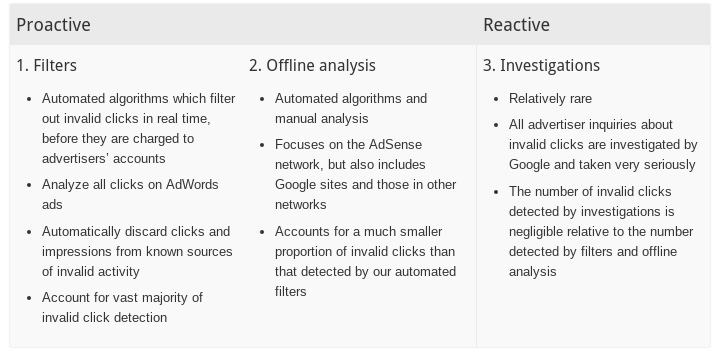Click frauds in Google Ads
Click fraud is one of the most talked about issues affecting advertisers on Google and other Pay Per Click (PPC) platforms.
What is Click Fraud?
Click fraud is a black-hat technique of falsely inflating the number of clicks on a pay-per-click ad. Click fraud is usually driven by one of two incentives:
- Advertisers are trying to sabotage their competitors by driving up their costs and meeting their budget caps early on in the day
- Ad publishers are clicking on the ads displayed on their own sites to generate more revenue for themselves.
About invalid clicks Google said:
„Clicks on ads that Google considers to be illegitimate, such as unintentional clicks or clicks resulting from malicious software.
- Here are just a few examples of what Google may consider to be invalid clicks:
- manual clicks intended to increase your advertising costs or to increase profits for website owners hosting your ads
- clicks by automated clicking tools, robots or other deceptive software
- extraneous clicks that provide no value to the advertiser, such as the second click of a double-click
- Each click on an ad is examined by our system, and Google has sophisticated systems to identify invalid clicks and impressions and remove them from your account data.
- When Google determines that clicks are invalid, we try to automatically filter them from your reports and payments so that you’re not charged for those clicks. If we find that invalid clicks have escaped automatic detection, you may be eligible to receive a credit for those clicks. These credits are called “invalid activity” adjustments.“

Three main types of click fraud:
1. Manual Clicks to Increase Your Ad Costs
These types of clicks are usually done by a competitor looking to drain your ad budget.
Let’s say you are ranking higher than your competitor in PPC search results. Your competitor doesn’t like it, clicks on your ads (a lot) to drive up your costs and, eventually, drive them so high that you can’t afford to advertise for those search terms anymore.
2. Manual Clicks to Increase Publisher Profits
If your PPC campaign is running on the Google Display Network, you could be open to this type of click fraud.
Each time an ad running on your campaign being hosted by a third party website is clicked, they earn a cut.
3. Automated Clicks Using Software
Hackers have built sophisticated click fraud systems that use fake IP addresses and web sessions, sometimes known as “bot farms.”
Automatic click fraud is often targeted through data stored in cookies. Bots will look at demographic information, browser histories, past purchases and many other data points before targeting a certain ad.
What Are Search Engines Doing About It?
For years, search engines have been getting a lot of flak for not going the extra mile to identify and quash click fraud. This suspicion is not unwarranted.
Remember, regardless of whether a click is malicious or not, it’s generating dough for the search engine displaying it.
So, to uphold their reputations (and put weary advertisers’ minds at rest), all of the major ad platforms have designated their very own task forces to take on click fraud.
Short conclusion
Google continues to improve its fraud detection capabilities and with help from advertisers this problem can be minimized.
